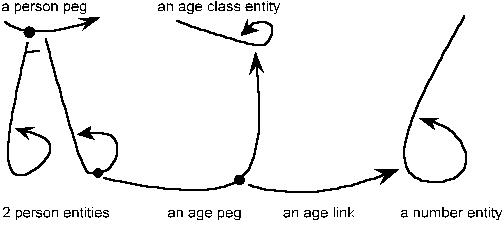Freedom from contaminating complexity is a good criterion for
evaluating almost any information product including ontologies.
In 1982 it was practical for me or colleagues at Digital
Equipment Corp to enter a statement in a very general
programming, data base, and modeling language for computer
execution such as:
6 = count every state where populatn of some city of it > 1000000
I would propose that a reasonable boundary on acceptable language
for writing ontologies is that it provide a comparable degree of
simplicity of _expression_. Anything less would be 30 years behind
the leading edge. Currently used languages are about 40 years
behind the leading edge because there has been little serious
effort to clean out extraneous complexity in the past 40 years.
Cleaning out extraneous complexity is a convergent process. There
gets to be little left. Opportunity to improve simplicity of
_expression_ stabilizes and so does the language. The process is
more convergent than is generally realized. Contrary to
conventional wisdom, the convergence does not depend much on
subject matter of the language except for superficial syntax.
The convergence applies to design choices for the
fundamental building blocks used to represent information. In
many contexts bits are a compelling choice but working with
bits at a conceptual level is usually too complicated.
We may ask: what is the structure (or structures) of building
blocks of information that are designed for maximum "modularity"?
That is, maximum simplicity in the _expression_ in a reasonably
small language (or languages) that use that structure (or
structures) in the data representations.
My analysis of the consequences of such thorough elimination of
extraneous complexity ("Toward Perfect Information
Microstructures" on my web site) leads to convergence toward an
enduring optimum structure for building blocks of information
that are designed to be easily arranged. They can be illustrated
thus:

This shows how the age of a person could be represented. The
objects have flexibility and tinker toy style connections making
them easily arranged conceptually. The upper left dot connects to
the first person in a set and its side connector connects to the
next person in the set of two. Those provide for iterating
through sets and easy reference to sets of objects using plural
expressions such as "every state" in the above example.
A permanent optimum modularity for information building blocks
can strengthen long term stability of language. With so little
effort
to simplify, convergence of the effort has largely gone unnoticed.
Being written in a sound durable general language seems like
a basic criterion for evaluating ontologies. The convergence which
people are unaware of makes it possible to get that right.
In order to evaluate technologies, there is a need to evaluate
the potential for such convergence in language design.
|
_________________________________________________________________
Msg Archives: http://ontolog.cim3.net/forum/ontology-summit/
Subscribe/Config: http://ontolog.cim3.net/mailman/listinfo/ontology-summit/
Unsubscribe: mailto:ontology-summit-leave@xxxxxxxxxxxxxxxx
Community Files: http://ontolog.cim3.net/file/work/OntologySummit2013/
Community Wiki: http://ontolog.cim3.net/cgi-bin/wiki.pl?OntologySummit2013
Community Portal: http://ontolog.cim3.net/wiki/ (01)
|
